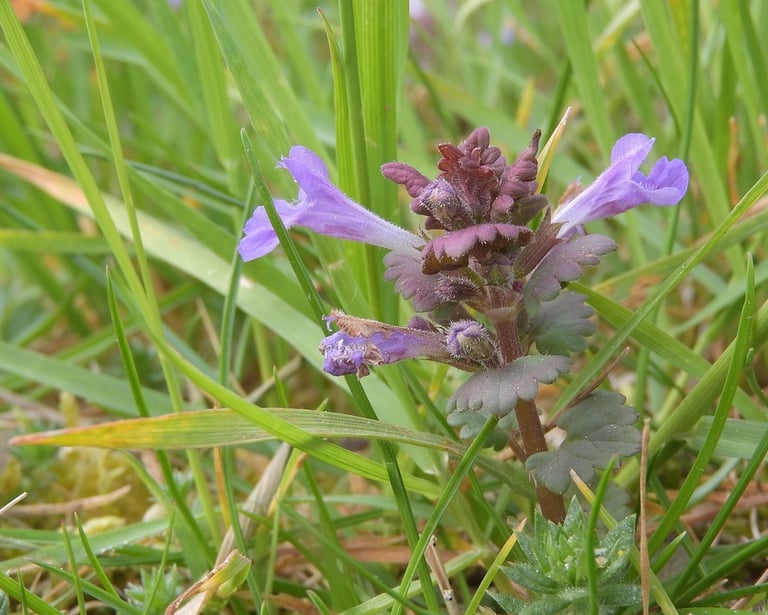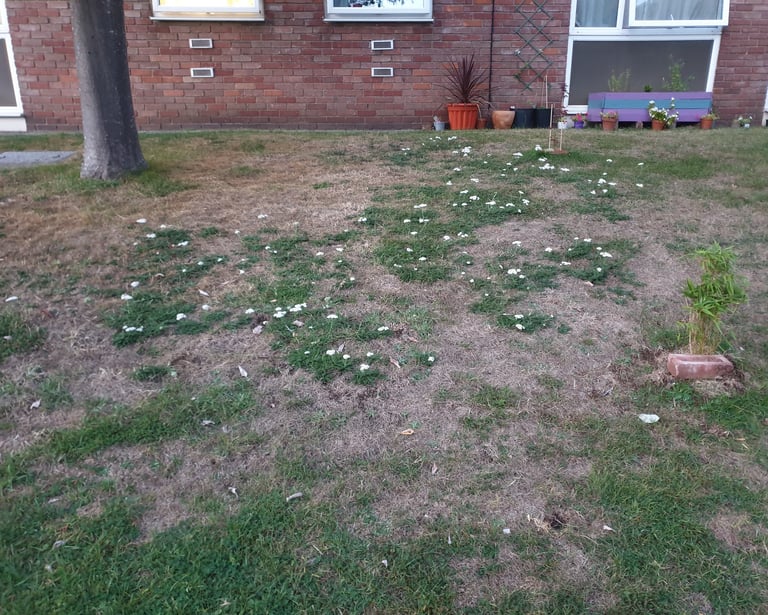10 plants for an eco-friendly lawn
Lawns have been called 'ecological deserts'; but do they need to be this way?
PLANT SPOTLIGHTGARDENING TECHNIQUESWILDLIFEGARDEN DESIGN
Bheinn
9/1/20255 min read


Spring and autumn is the time to sow lawn seed in the UK, however lawns have been the object of increasing criticism in recent years owing to their role in biodiversity loss. Lawns have only existed since the 13th century at which point they surrounded Scottish castles, in the 16th century becoming status symbols of the European aristocracy, symbolising wealth, social prestige and leisure. These social trends had trickled down to the average homeowner by the 20th century, and with the advent of petrochemical fertilizers in the 1950's and then herbicides in the 1970's, the mass market lawn care industry was born. These technological innovations meant greener lawns owing to nitrogen fertilizer, and less 'weeds' thanks to herbicides. The dandelion, itself a rather humble and unobtrusive plant, is typically viewed as deeply undesirable in a lawn, disrupting the perfect green uniformity of the grass with its dentate leaf margins and bright yellow flowers, a blemish on the otherwise spotless mind of the homeowner. But here we are in 2025 and we now understand the crucial importance of our own personal contribution, however small it may be, to the ecosystem around us. Since the 1930's there has been a 97% decline in wildflower meadows in the UK, owing to the post WW2 'Green Revolution' made possible by petrochemical fertiziler, and now only 1%-2% of UK grasslands are considered 'species rich'. Pollinators are accordingly in decline, as evidenced by the famous 'windscreen test'. When was the last time you walked through a field of birds foot trefoil, scabious or knapweed in the UK? These habitats would have been well known to our great-great grandparents but are now rarely experienced.
So, a worrying picture, but does it necessitate the destruction of your lawn? Whilst this is a commendable approach and one I have taken myself in my own garden, there is actually a way to keep your grassy patch whilst also benefitting local pollinators.
Here's a list of commonly available flowering plants that are popular with pollinators and tolerate footfall and repeated mowing (although mowing should always be limited to allow flowering for pollinators). In fact, study the next lawn you come across and you may find many of these species disguised amongst the grass!


Trifolium repens | white clover
White clover is a very common occurence in fields, parks and lawns. It is low growing and can tolerate grazing (or mowing) and due to its deep taproots stays green through a dry summer where grass will begin to die. It is in fact so good in lawns that you can entirely substitute grass for white clover, and being a legume or member of the pea family it fixes its own nitrogen from the atmosphere, making fertilizer use entirely unnecessary.


Trifolium pratense | red clover
Taller than its close relative, red clover its also suitable for lawns and has attractive magenta flowers through the summer, though wood suit a slightly taller lawn.


Lotus corniculatus | birds-foot trefoil
Bird's foot trefoil is a highly attractive low growing native member of the pea family. There is also a taller growing close relative, greater bird's foot trefoil, that is more suitable for longer grassy borders or wildflower meadows.


Ajuga reptans | bugle
Ajuga, commonly known as bugle, is a beautiful blue-flowered member of the mint family Lamiaceae. These mat-forming groundcovers are native and are available in a variety of cultivated forms, but in a lawn the wild form might be best.


Glechoma hederacea | ground ivy
Another member of the mint family, ground ivy is a beautiful and dainty creeping plant that grows well amongst short grass.


Achillea millefolium | yarrow
This attractive member of the sunflower family is available in garden centres in a range of flower colours, but the wild white (occassionally pink) flowered form might be most suitable for lawns as the plants are shorter and can tolerate repeated mowing. As with all eco friendly lawns, reduce frequency of mowing to allow flowering and pollinator activity. Yarrow, like all other plants in this list, has deeper roots than grass, meaning it stays green during droughts when grass will die off (see photo).


Allium schoenoprasum | chives
Chives disguise themselves so closely amongst grass that you have to be looking quite closely to notice them, but they are very frequent in grassy areas. They are edible and produce beautiful purple flowers.


Ranunculus repens | buttercup
Buttercups - cheery and great for pollinators, these plants have tenacious roots that are difficult to remove. They appear in lawns and gardens frequently.


Taraxacum officinale | dandelion
Sworn enemy of the lawn owner and loved by kids, these cheery flowers will appear in your lawn. How many you keep is up to you. Dandelions are among the first flowers to open in spring when bees emerge from hibernation and nectar is scarce, and continue flowering all the way through the summer, attracting goldfinches when seeds ripen at the end of summer.


Bellis perennis | daisy
Last but not least is the inimitable daisy. These small plants are so ubiquitous in mown grassy spaces that it will be a suprise if they don't appear in your lawn at some stage, even if you don't plant them. There are some cultivars available but single-flowered forms are always best for pollinators.
Some of these plants will appear in your lawn as volunteers, others may need to be introduced. They should all establish well when sown from seed in prepared soil in spring or autumn, and are generally much more tolerant of drought than grass, which only has shallow roots, meaning your lawn will stay green in mid summer when grass dies off.
If you have a larger lawn, why not consider mowing paths in the grass and leaving the rest to grow taller. This way you can incorporate taller flowering plants such as ox-eye daisy, knapweeds, cornflowers, vetch and various other meadow flowers. If you have a sunny patio garden, consider sowing creeping thyme (Thymus serpyllum) between and around paving slabs for a fragrant carpet of purple flowers through the summer. Get creative!
Trefoil Garden Maintenance
Organic gardening services in Bristol and surrounds
Contact
Subscribe to my mailing list
+44 74 810 096 42
© Trefoil Garden Maintenance 2025. All rights reserved.
